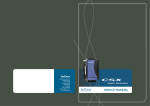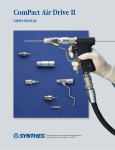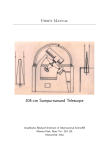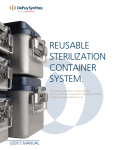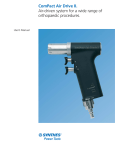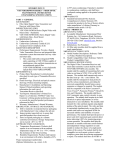Download User`s Manual
Transcript
Compartmental Pressure Monitoring System. For continuous measurement of intracompartmental pressure. User’s Manual Table of Contents Introduction Instructions Product Information Compartmental Pressure Monitoring System 2 Indications 4 Operating Instructions 5 Care and Maintenance 8 Sterilization 11 System Messages and Troubleshooting 12 Checking the Number of Remaining Measurements 13 Changing the Battery 14 Set List 15 Synthes Compartmental Pressure Monitoring System Monitor (530.411) – Liquid crystal display (LCD) – Standard 9 V battery (6LR61) – Measures from 0 to 200 mm Hg – Displays pressure in 1 mm Hg increments – Weight, including battery: 235 gm – Operating temperature: 10°C– 40°C (50°F – 104°F) – Storage temperature: 10°C–55°C (50°F – 131°F) – Protection class: BF (body floating) protection against electrical shock Connector Monitor turns on automatically by plugging in the probe or the probe – extension cable assembly LCD display Displays system messages, pressure measurements and probe usages remaining Battery compartment Houses a 9 V battery This device complies with the following standards: UL 94VO (housing) EN 60601-1 EN 60601-1-1 EN 60601-1-2 2 Synthes Compartmental Pressure Monitoring System User’s Manual Probe (530.412) – Converts pressure to an electrical signal – Powers system on when connected to the monitor – Built-in usage counter is decreased during the initialization phase each time the probe is connected to the monitor* – Sterilizable and reusable 25 times, after which the probe no longer functions and the hand-held monitor displays the message: “NO MEASUREMENTS AVAILABLE — CHANGE PROBE” – Size: 4 French – Total length: 64 cm – Requires a 14 gauge intravenous cannula for insertion into the compartments Sensor window Connector Extension Cable (530.413) – May be used to connect a probe to the monitor – 2 meter (6.5 foot), sterilizable cable – Preserves the sterile field when measuring compartmental pressure in the operating room – Convenient for indwelling, continuous pressure monitoring *To check the number of measurements left without decreasing the counter, refer to page 13. Synthes 3 Indications The Synthes Compartmental Pressure Monitoring System is intended for the immediate or continuous measurement of intracompartmental pressures. The system includes a hand-held monitor with a liquid crystal display, a probe and an optional extension cable. Pressure detected by the unicrystalline piezoelectric semiconductor embedded at the end of the probe creates an electric signal that is sent to the hand-held monitor and displayed. 4 Synthes Compartmental Pressure Monitoring System User’s Manual Operating Instructions Important: The probe and extension cable are provided nonsterile. They must be cleaned and sterilized prior to first use and between uses, following the cleaning and sterilization instructions provided in this manual. 1 Prepare puncture site Prepare the puncture site according to hospital guidelines and inject local anesthetic if necessary. 2 Connect sterile probe Connect a sterile probe or the probe – extension cable assembly to the monitor. 3 Observe display Observe the display until the message “SYSTEM READY” appears, followed by “000 mmHg.” (Refer to the System Messages and Troubleshooting section, page 11, for all messages displayed.) Synthes 5 Operating Instructions continued 4 Insert cannula Insert a 14 gauge intravenous cannula into the muscle compartment. Remove the trocar carefully, making sure the cannula remains in place. 5 Insert probe Insert the probe into the muscle compartment through the cannula. 6 Retract cannula Retract the cannula completely. If repeated measurements through the same site are planned, make sure to retract the cannula at least one centimeter from the tip of the probe to expose the sensor. 6 Synthes Compartmental Pressure Monitoring System User’s Manual 7 Read pressure Read the compartment pressure displayed on the monitor. 8 Determine risk Determine patient risk using the pressure displayed or calculate ΔP (diastolic pressure minus pressure displayed). Caution: To avoid false high readings, care should be taken to insert the needle and probe parallel to the muscle fibers. The measurement is an indication of the pressure at the insertion site. If the needle is inserted into the intramuscular tendon, or if crosswise tensed muscle fibers press on the measuring window, a false high reading may be obtained. The surgeon should exercise clinical judgment and use other available information, including symptoms, when diagnosing compartment syndrome. Synthes 7 Care and Maintenance Cleaning the monitor To clean the monitor, wipe with a soft cloth and a mild detergent. Important: Do not use solvents to disinfect the monitor. Do not place under water or immerse into liquids. The connector must not contact water or solvent: Danger of short-circuiting! Do not sterilize the monitor! 8 Synthes Compartmental Pressure Monitoring System User’s Manual Cleaning the pressure measuring probe Important: Failure to follow the cleaning instructions properly may render the probe unusable. – Always clean and sterilize the probe before the first surgical use, and immediately after each subsequent use. – Never immerse the connector in water or cleaning solution. – Always place the silicone cap over the connector prior to cleaning and sterilizing the probe. – Do not use ultrasonic baths to clean the probe – Do not use brushes, wires, needles, sharp objects or other mechanical aids to clean the probe. – Do not attempt to dislodge objects or dried blood from the sensor window using sharp objects, pickups, or by rubbing with fingernails. Use only lukewarm water and a paper towel. – Do not use hydrogen peroxide, sodium hypochlorite or solvents to clean the pressure measuring probe. 1 Run water over probe tip Manually remove blood and body fluids by running lukewarm (maximum 65°C / 149°F) water over the tip of the probe. If the probe cannot be cleaned immediately after use, place the probe tip in a bowl of water to ensure that the blood does not dry on it. Do not place the connector in the water. 2 Wipe probe Carefully wipe the probe with a paper towel. Avoid applying excessive pressure on the sensor window. 3 Rinse with water Rinse the probe with distilled water. 4 Wipe with disinfectant Wipe the connector with a 70% alcohol disinfectant. Do not immerse the connector. Synthes 9 Care and Maintenance continued Disinfecting the pressure measuring probe Always follow the instructions of the manufacturer of the disinfecting solution when disinfecting the probe. Care should be taken never to immerse the connector in disinfecting solution. The probe should be rinsed with distilled water and allowed to dry prior to sterilization. Cleaning the extension cable Important: Do not immerse the connectors. Wipe the cable and connectors with a 70% alcohol disinfectant. If blood has dried on the cable, soak the cable in a bowl of lukewarm water to dissolve the blood. Do not immerse the connectors. 10 Synthes Compartmental Pressure Monitoring System User’s Manual Sterilization Steam autoclave temperature should not exceed 134°C. Temperatures in excess of 134°C will damage the probe. The silicone cap prevents steam from entering the connector, to protect the electronic circuitry in the probe. The inside of the connector is therefore not sterile, and precautions should be taken to ensure that sterile personnel do not touch the inside of the connector while plugging it into the sterile extension cable or nonsterile monitor. Synthes recommends a 10-minute drying cycle and a 30-minute cooling time after the probe has been removed from the autoclave prior to use. These parameters are validated to sterilize only these devices. The autoclave must be properly installed, maintained, and calibrated. Important: Do not sterilize the hand-held monitor. The probe and extension cable should be steam sterilized in accordance with the following guidelines. Time Wrapped Prevacuum Unwrapped Prevacuum Temperature Minimum Exposure 132° – 134°C (270° – 273°F) 4 minutes 132° – 134°C (270° – 273°F) 4 minutes Synthes 11 System Messages and Troubleshooting The hand-held monitor displays messages referring to the status of the system. If the display does not come on when the probe is connected, replace the battery. If suggested solutions are unsuccessful, call the Synthes Service Department at 1-800-288-6698 for servicing information. Message Description Action Required Measurements available XX Number of measurements available for the probe plugged into the monitor. None System ready The system is operational and ready to be used. None 000 mmHg The system is ready to measure the pressure. Insert the probe in the compartment to be measured, using the 14 gauge cannnula. Battery low The battery is low. Keep using the hand-held monitor until the Battery Empty message is displayed. Change the battery before next use. Battery empty – change battery The battery is drained. Do not unplug the probe from the monitor. Do not remove the probe from the compartment. Replace the battery with a new 9V (6LR61) battery. The system will reinitialize without decreasing the probe’s counter. Wrong probe The hand-held monitor does not recognize the probe. Use a Synthes Probe (530.412) only. Probe overheated during sterilization The probe was sterilized at a temperature higher than 134°C Replace the probe. No measurements available — change probe The probe has been used 25 times. Replace the probe. Probe malfunction The probe is damaged. Replace the probe. System malfunction The probe is damaged. Replace the probe. 12 Synthes Compartmental Pressure Monitoring System User’s Manual Checking the Number of Remaining Measurements The Compartmental Pressure Monitoring System allows the user to verify the number of measurements left on a probe without decreasing the probe’s counter. To check the number of remaining measurements: 1 Connect probe to monitor Connect the probe to the hand-held monitor. 2 Observe display Observe the display attentively for the following messages: “Synthes Compartmental Pressure Monitoring System CPMS Version XX X”. “Measurements Available XX” 3 Disconnect probe Immediately disconnect the probe from the hand-held monitor. Disconnecting the probe at this point ensures that the probe’s counter has not been decreased. Important: The probe should be disconnected after the number of measurements available is displayed. The probe’s counter will be decreased 3 seconds after the first display of the number of measurements available. Following the 3 seconds, the message “Measurements Available XX” will be displayed again, showing that the counter has now been decreased by one measurement. Synthes 13 Changing the Battery The monitor uses a standard 9 V battery (type 6LR61). The battery is housed within the battery compartment on the back of the hand-held monitor. To open the battery compartment, use a Synthes 2.5 mm hexagonal screwdriver. The battery compartment lid can be opened without completely removing the screws. When replacing the battery, match the polarity indicated in the battery compartment. Reversing the polarity when inserting the battery may damage the unit. Once the battery has been secured in the battery compartment, position the battery compartment lid and tighten the screws. The screws should not be over-tightened, as this may damage the screw threads or the battery compartment lid. 14 Synthes Compartmental Pressure Monitoring System User’s Manual Compartmental Pressure Monitoring System (150.001) 306.001 530.411 530.412 530.413 Carrying Case Monitor Probe Extension Cable Synthes 15 Synthes (USA) 1302 Wrights Lane East West Chester, PA 19380 Telephone: (610) 719-5000 To order: (800) 523-0322 Fax: (610) 251-9056 © 2000 Synthes, Inc. or its affiliates. All rights reserved. Synthes (Canada) Ltd. 2566 Meadowpine Boulevard Mississauga, Ontario L5N 6P9 Telephone: (905) 567-0440 To order: (800) 668-1119 Fax: (905) 567-3185 Synthes is a trademark of Synthes, Inc. or its affiliates. www.synthes.com Printed in U.S.A. 2/10 J4990-C

















